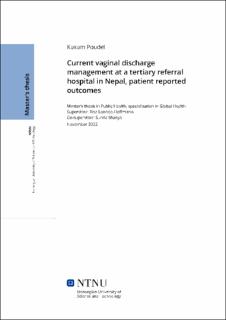| dc.description.abstract | Background: Abnormal vaginal discharge is a common medical problem among women of childbearing age, with an estimated 5–10 million clinic visits each year worldwide. (1,2,12) Due to hesitation to undergo vaginal examination and unavailability of equipment to do vaginal examination in health facilities, diagnosis of STI is solely done on the basis of symptoms and same approach is used for bothersome vaginal discharge as well. (8) In order to start addressing this problem of overtreatment with antibiotics we should know the numbers of women presenting with vaginal discharge in any health care setting in Nepal. No such reports concerning this issue have been found. Further, we don’t know what proportion of women presenting with abnormal vaginal discharge do receive antibiotics. If this diagnostic and treatment approach is planned to be changed in the future, it will be important to know more about the patient’s satisfaction with the consultation as well as the treatment to describe the subjective symptom development after standard treatment and if it is related further it can help in improvement. No such study has been done on this subject yet. Therefore, this study aims to determine current vaginal discharge management at tertiary level hospital.
Methods: We conducted cross-sectional study with follow up on women visiting OBGYN department of Dhulikhel hospital. Dhulikhel Hospital is located at Kavrepalanchwok district of Nepal. Data collection was done in OPD of OBGYN department of hospital. For collecting data random selection of OBGYN OPD was done. Randomization was done by throwing a dice where 1 represented OPD 1, 2 was OPD 2 and 3 was OPD 3 respectively. Each consecutive patient of the OPD which came by throwing dice was included in that day. If they gave written consent, they were included in part 1 to find out the proportion and women with bothersome vaginal discharge who gave consent to attend the follow up phone call were included in part II of the study. On the given time frame, we expected that it will be realistic to sample the information of 100 women presenting with vaginal discharge. This would produce the following estimates a sample size of 200 women with and without vaginal discharge. But due to limited time frame we could collect data of 56 women with vaginal discharge and 144 women without vaginal discharge. As the questionnaire was non-validated, a pilot test was conducted and questions were modified accordingly. We determined the factors associated with bothersome vaginal discharge by performing Chi-Square and Fisher Exact test.
Results: Overall prevalence of self-reported bothersome vaginal discharge among the participants was 28%, which was second most reported cause for the hospital visits after low abdominal pain. Among women with self-reported bothersome vaginal discharge majority (89.3%) complaint of having whitish discharge. Among 56 women self-reporting vaginal discharge 80.4% received antibiotics. On a scale of 1 to 10 (0 being least satisfied, 10 being most satisfied and 6 being moderately satisfied) an average 85.71% of women were very satisfied with the consultation with the mean score 8.32±1.674 and 64.29% were very satisfied with the treatment with the mean score 7.2±3.289. There was significant association between bothersome vaginal discharge and women’s educational status (p=0.029).
Conclusion: About one third of all women visiting the gynecology out-patient ward at Dhulikhel hospital had complaint of self-reported bothersome vaginal discharge which was second major cause for the women to visit the hospital preceded by lower abdominal pain. Bothersome vaginal discharge was more commonly reported among the women with low education status. One third women with self-reported abnormal vaginal discharge had moderately bothersome vaginal discharge. Almost all women were very satisfied with the examination at the hospital. Targeting women with low educational level may raise awareness regarding reproductive health. Possibly, promoting healthy sexual behavior and hygienic practices may reduce complain of vaginal discharge in women with low educational level. | |
